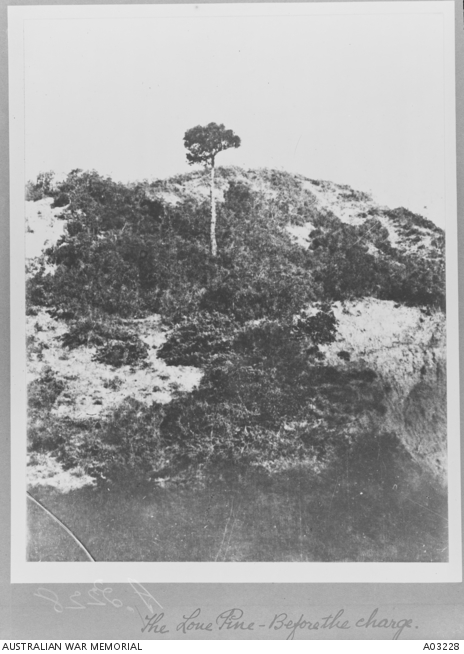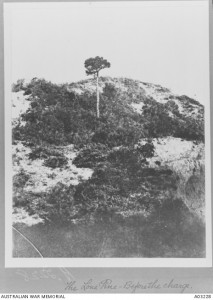Lone Pine Ridge (or Plateau 400) on the Gallipoli Peninsula in Turkey was the scene of a major diversionary offensive lead by the 1st Australian Infantry Division on 6 August 1915. The ridge had been dominated by the Pinus halepensis tree, commonly known as the Aleppo Pine. The Turks had cut down all but one of these pines and used them to cover their trenches.
The Battle of Lone Pine was centred in a small area in the vicinity of the last remaining pine. Australia lost more than 2,000 men in the Battle; the Turks, 7,000 men.
Seven Victoria Crosses were awarded during the Battle of Lone Pine. Orange born John Patrick Hamilton was awarded his VC for conspicuous bravery at Lone Pine on 9 August 1915.
At least two Australian soldiers souvenired pine cones from Lone Pine Ridge and brought them home after World War I.
The first pine cone was collected by Lance Corporal Benjamin Smith of the 3rd Battalion, whose brother was killed during the Battle of Lone Pine. Smith sent the cone home to his mother, Mrs McMullen of Cardiff in NSW. Mrs McMullen kept the cone for 13 years before planting seeds from the cone in 1928. Three seedlings flourished (possibly representing her three sons that fought at Gallipoli). Mrs McMullen presented one seedling to the City of Inverell, who planted the pine in the Victoria Park. The second seedling was given to the Department of the Interior in Canberra. This tree was planted at the Australian War Memorial in October 1934 by the visiting Duke of Gloucester. Today it stands over 20 metres in height. Unfortunately the third seedling (like her son) did not survive.
Sgt Keith McDowell of 24th Battalion also souvenired a cone from the Lone Pine, carrying it in his haversack until the end of the war. On his arrival home he gave it to his aunt, Mrs Emma Gray, from Grassmere near Warrnambool in Victoria. A decade later Mrs Gray planted the seeds and four seedlings grew. One was planted in Wattle Park in Melbourne in May 1933, and another at the Shrine of Remembrance in Melbourne. The third was planted at the Soldiers Memorial Hall at The Sisters, and the fourth in Warrnambool Gardens.
Many trees have been propagated from the pine at the Australian War Memorial in Canberra. There are a number of ‘Lone Pines’ in Orange, all in one way or another close relatives of the original tree from the Lone Pine Ridge at Gallipoli. The first ‘Lone Pine’ in Lone Pine Avenue in Orange was probably descended from the Australian War Memorial tree. A number of trees have since been propagated from the pine in Lone Pine Avenue. There is a pine in front of the RSL Memorial Hall, one at Duntryleague Golf Club and another at the Orange Agricultural Research Station.
* Cr Reg Kidd, 5 February 2014
Post script
The tree in the main park in Inverell was later removed, due to its age and excessive weather damage. I was present at the time and was given two cross sections of the trunk. One was presented to the RSL in Orange, and the other will form part of an upcoming WWI display at Orange City Library. I also have a cone from the Inverell tree.
Whilst visiting Gallipoli in 2010 I was fortunate enough to receive a cone from the pine from the Lone Pine War Memorial. This tree was one of two trees given to the Turkish Government to commemorate the 75th Anniversary of the Battle of Lone Pine in 1990. This tree was propagated from the second pine that Mrs McMullen grew at Cardiff in 1928.


